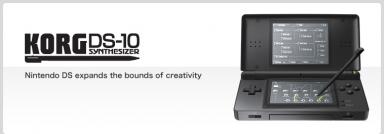I thought the Nintendo DS was just a games console, right? Wrong. It's one of many devices that are being reinterpreted due to the considerable potential of their interfaces. So now your DS is a Korg MS-10 synth, and your iPhone is in fact a piano. And lets not get started on the plethora of Wii hacks.

I like how this trend is growing - it seems that our products are becoming increasingly unspecific: they perform as comfortably with one function as quite another, and don't look out of place in the process either. Presumably this is because each are essentially portable computers, and have completely customisable interfaces: the iPhone through its multi-touch screen, the DS through its dual screens, and the Wii simply through its gestural controllers-and-TV combo. And the manufacturers are happy to encourage this multifunctionality, as the industrial design is generally so minimal and anonymous, we can subconciously (and to some extent physically) project onto it the aesthetics of any device.
 We never saw this much cross-functionality in, say, the classic iPods, or, dare I say, the PSP. Even if the 4G iPod was easier to reprogram, it just wouldn't be any fun playing a piano keyboard through a jogwheel and one button! Likewise, the PSP with its standard game controller interface just doesn't suit much other than games, even playing music and images on it being a bit of a semantic chore. These were sophisticated and heralded designs, but restricted by their interfaces, or rather, with carefully honed interfaces, optimum to one type of task: in the iPod's case, going through lists, and in the PSP's case, controlling a game with speed and ergonomy [I'm sure unwanted iPods could be put to great use as portable catalogues for a museum, or as menus for a restaurant) .
We never saw this much cross-functionality in, say, the classic iPods, or, dare I say, the PSP. Even if the 4G iPod was easier to reprogram, it just wouldn't be any fun playing a piano keyboard through a jogwheel and one button! Likewise, the PSP with its standard game controller interface just doesn't suit much other than games, even playing music and images on it being a bit of a semantic chore. These were sophisticated and heralded designs, but restricted by their interfaces, or rather, with carefully honed interfaces, optimum to one type of task: in the iPod's case, going through lists, and in the PSP's case, controlling a game with speed and ergonomy [I'm sure unwanted iPods could be put to great use as portable catalogues for a museum, or as menus for a restaurant) .
 So our new generation of touchscreen and gestural devices provide a standard for building much better customised interfaces - but is there a loss in effectiveness? We can have, say, our musical instrument interfaces just the way we like them on a touchscreen but they will only ever be an approximation of the tangible interface. What will happen when there is a platform for 'programming' a tangible interface to a computery gadget, so that when one loads up a program, with it are loaded up new, physical, knobs, keys and sliders all of the optimum type and position?
So our new generation of touchscreen and gestural devices provide a standard for building much better customised interfaces - but is there a loss in effectiveness? We can have, say, our musical instrument interfaces just the way we like them on a touchscreen but they will only ever be an approximation of the tangible interface. What will happen when there is a platform for 'programming' a tangible interface to a computery gadget, so that when one loads up a program, with it are loaded up new, physical, knobs, keys and sliders all of the optimum type and position?
That might be what's needed to marry the oft-conflicting desires for multifunctionality and simplicity - two factors at the heart of how we customise tangible devices.
Images- Left: MooCowMusic: Pianist; Middle: iPod Linux; Top: Korg DS-10



No comments:
Post a Comment